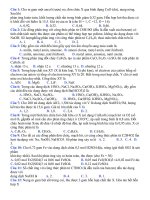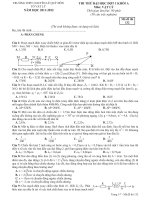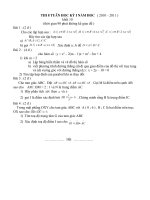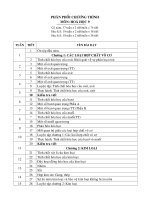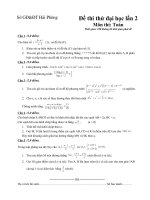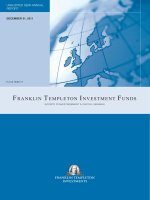Astm a 1048 a 1048m 06 (2011)
Bạn đang xem bản rút gọn của tài liệu. Xem và tải ngay bản đầy đủ của tài liệu tại đây (81.13 KB, 3 trang )
Designation: A1048/A1048M − 06 (Reapproved 2011)
Standard Specification for
Pressure Vessel Forgings, Alloy Steel, Higher Strength
Chromium-Molybdenum-Tungsten for Elevated Temperature
Service1
This standard is issued under the fixed designation A1048/A1048M; the number immediately following the designation indicates the
year of original adoption or, in the case of revision, the year of last revision. A number in parentheses indicates the year of last
reapproval. A superscript epsilon (´) indicates an editorial change since the last revision or reapproval.
A966/A966M Practice for Magnetic Particle Examination of
Steel Forgings Using Alternating Current
1. Scope
1.1 This specification covers chromium-molybdenumtungsten alloy steel forgings intended primarily for use in
boilers and pressure vessels for elevated temperature service.
1.1.1 Elevated temperatures are temperatures in the range
where creep and stress rupture properties are important for the
alloy steels in this specification.
3. Ordering Information and General Requirements
3.1 In addition to the ordering information required by
Specification A788/A788M, the purchaser should include with
the inquiry and order the following information:
3.1.1 A drawing, sketch, or written description of the
required forging and the manner of providing test material (see
Section 6).
3.1.2 Desired supplementary requirements including those
from Specification A788/A788M.
3.1.3 Requirements for alternate ultrasonic examination
procedure (see 7.1.2).
3.1.4 At the purchaser’s option Test Method A966/A966M
shall be used for the magnetic particle examination.
1.2 Supplementary requirements are provided both in this
specification and in the General Requirements Specification
A788/A788M for use when additional testing or inspection is
desired. These shall apply only when specified individually by
the purchaser in the purchase order or contract.
1.3 Unless the order specifies the applicable “M” specification designation, the forgings shall be supplied to the inchpound units.
1.4 The values stated in either inch-pound or SI (metric)
units are to be regarded separately as standard. Within the text
and tables, the SI units are shown in brackets. The values stated
in each system may not be exact equivalents; therefore, each
system shall be used independently of the other. Combining
values from the two systems may result in nonconformance
with the specification.
3.2 Forgings supplied to this specification shall conform to
the requirements of Specification A788/A788M which, in
addition to ordering information, includes manufacturing requirements, testing and retesting methods and procedures,
marking, certification, product analysis variations and additional supplementary requirements.
3.3 If the requirements of this specification are in conflict
with those of Specification A788/A788M, the requirements of
this specification shall prevail.
2. Referenced Documents
2.1 ASTM Standards:2
A275/A275M Practice for Magnetic Particle Examination of
Steel Forgings
A388/A388M Practice for Ultrasonic Examination of Steel
Forgings
A788/A788M Specification for Steel Forgings, General Requirements
4. Materials and Manufacture
4.1 The steel melting procedures of Specification A788/
A788M shall apply except that the open hearth process shall
not be used, and that the molten steel shall be vacuum degassed
prior to or during teeming of the ingot to remove objectionable
gasses, notably hydrogen.
4.2 Heat Treatment:
4.2.1 After being permitted to transform following completion of forging the material may be given an intermediate heat
treatment such as normalizing and tempering or a subcritical
anneal prior to preliminary machining to the required heat
treatment contour. The purchaser may specify supplementary
requirement S1 to have the forgings rough machined before the
final heat treatment.
1
This specification is under the jurisdiction of ASTM Committee A01 on Steel,
Stainless Steel and Related Alloys and is the direct responsibility of Subcommittee
A01.06 on Steel Forgings and Billets.
Current edition approved Oct. 1, 2011. Published January 2012. Originally
approved in 2006. Last previous edition approved in 2006 as A1048/A1048M – 06.
DOI: 10.1520/A1048_A1048M-06R11.
2
For referenced ASTM standards, visit the ASTM website, www.astm.org, or
contact ASTM Customer Service at For Annual Book of ASTM
Standards volume information, refer to the standard’s Document Summary page on
the ASTM website.
Copyright © ASTM International, 100 Barr Harbor Drive, PO Box C700, West Conshohocken, PA 19428-2959. United States
1
A1048/A1048M − 06 (2011)
6.6 For heat-treated weights over 10 000 lb [4500 kg] and
heat-treated lengths up to 10 ft [3 m], excluding the test
prolongation, two sets of mechanical test specimens shall be
taken from an integral prolongation at one end of each forging.
These sets shall be located 180° apart and each set shall consist
of one tension test and a Charpy test.
6.6.1 For heat-treated weights over 10 000 lb [4500 kg] and
heat-treated lengths over 10 ft [3 m], a test prolongation is
required to be located at each end of the forging. One set of
mechanical test specimens shall be taken from each prolongation, and each test set shall consist of one tension test and a
Charpy test.
4.2.2 Heat treatment applied either after rough machining or
directly after cooling from forging shall consist of normalizing
and tempering as follows:
Normalize from 1950 to 2050°F [1065 to 1120°C]
Temper at 1290 to 1400°F [700 to 760°C]
4.2.3 Multiple normalize or temper cycles, or both, may be
applied providing the final stages comply with the temperatures
shown in 4.2.2.
5. Chemical Composition
5.1 Heat Analysis—The heat analysis obtained from
samples taken in accordance with Specification A788/A788M
shall comply with Table 1.
6.7 The tension and Charpy test results shall conform to the
requirements of Tables 2 and 3, respectively.
5.2 The manufacturer shall use the product analysis provisions of Specification A788/A788M to obtain a product analysis from a forging representing each heat or multiple heat. The
purchaser may also make this determination in accordance with
Specification A788/A788M.
7. Nondestructive Examination
7.1 Ultrasonic Examination:
7.1.1 Forgings shall undergo ultrasonic examination in accordance with the procedures of Practice A388/A388M.
7.1.2 Straight-Beam Examination—Unless otherwise specified by the purchaser (see 3.1.3) back-reflection method shall
be used.
7.1.3 In addition to the reportable conditions referenced in
Practice A388/A388M indications exceeding the resultant
back-reflection shall be recorded.
7.1.4 A forging shall be considered to be unacceptable when
one or more reflections are present producing indications
accompanied by a complete loss of back-reflection, not attributable to nor associated with the geometric configuration. For
this purpose a back-reflection of less than 5 % of full screen
height shall be considered to be complete loss of backreflection.
7.1.5 Angle-Beam Examination—Bored or hollow forgings
shall be provided with calibration notches in accordance with
Practice A388/A388M.
7.1.6 A forging that contains a discontinuity that results in
an indication exceeding the amplitude of the reference line is
subject to rejection.
7.1.7 The report of the complete ultrasonic test shall be in
compliance with Practice A388/A388M.
6. Mechanical Properties
6.1 Tension and Charpy impact test specimens shall be
oriented in the longitudinal direction, that is, with their major
axes parallel to the direction of maximum working.
6.2 Both the tensile and Charpy impact specimens shall be
located at the mid-radius or 1⁄4 thickness location in the integral
test prolongation or, if applicable (see 6.4), in the test forging.
6.3 The integral test prolongation or prolongations shall be
no smaller in diameter or effective section thickness than the
maximum diameter or cross section of the connected forging.
6.4 For forgings weighing 5000 lb [2250 kg] or less at the
time of heat treatment, a separately forged test bar may be used
to provide material for mechanical testing.
6.4.1 The heat-treated diameter or section thickness of the
test forging must be at least equal to the heat-treated diameter
or effective section of the forgings it represents.
6.4.2 One test forging, yielding one tension test and a
Charpy impact test (consisting of three specimens) is required
to represent each heat in each heat treatment charge.
6.5 For heat-treated weights over 5000 lb [2250 kg] but not
more than 10 000 lb [4500 kg] an integral prolongation is
required at one end of each forging. One tension test and one
Charpy test (three specimens) is required for each forging.
7.2 Magnetic Particle Examination :
7.2.1 Each forging shall be examined by a magnetic particle
method in accordance with Test Method A275/A275M after
heat treatment and in the final machined condition, except that
at the purchaser’s option (see 3.1.4) the AC Yoke from Test
Method A966/A966M shall be used.
7.2.2 Only indications with major dimensions exceeding 1⁄16
in. [1.5 mm] shall be considered to be relevant. The following
relevant indications are unacceptable:
TABLE 1 Chemical Composition %
Element
Carbon
Manganese
Phosphorous, max
Sulfur, max
Silicon
Nickel, max
Chromium
Molybdenum
Vanadium
Boron, max
Tungsten
Tantalum
Aluminum, max
Grade 315
Grade 315Ta
0.08-0.12
0.25-0.45
0.010
0.010
0.15-0.40
0.25
2.8-3.2
0.65-0.85
0.20-0.30
0.0007
1.35-1.75
...
0.015
0.08-0.12
0.25-0.45
0.010
0.010
0.15-0.40
0.25
2.8-3.2
0.65-0.85
0.20-0.30
0.0007
1.35-1.75
0.07-0.13
0.015
TABLE 2 Tensile Requirements
2
Property
Grade 315 and Grade 315Ta
Tensile Strength, ksi [MPa]
Yield Strength, ksi [MPa] min
Elongation in 2 in. [50 mm], % min
Reduction of Area, % min
105-135 [725-930]
85 [585]
16
50
A1048/A1048M − 06 (2011)
TABLE 3 Charpy V-Notch Impact Requirements Tested at
32°F [0°C] max
Property
Lateral Expansion, mils [mm] min
Min Average Absorbed Energy, ft-lbf [J]A
Min Single Value, ft-lbf [J]
A
7.2.2.3 Four or more relevant indications (linear or rounded)
in a line and separated by 1⁄16 in. [1.5 mm] or less, edge to edge.
7.2.2.4 Ten or more relevant indications in any
6 in.2 [40 cm2] of surface with the major dimension of this area
not to exceed 6 in. [150 mm].
Grades 315 and 315Ta
25 [0.6 mm]
35 [48]
25 [34]
Not more than one specimen from a set of three may be below this value.
8. Certification and Reports
8.1 In addition to the certification and reporting requirements of Specification A788/A788M, the manufacturer shall
include the following:
7.2.2.1 Any linear indication greater than 1⁄16 in. [1.5 mm] in
length for forgings up to and including 1 in. [25 mm] in
thickness, or greater than 1⁄8 in. [3 mm] in length for forgings
greater than 1 in. [25 mm] but not more than 3 in. [75 mm] in
thickness, or greater than 3⁄16 in. [5 mm] in length for forgings
greater than 3 in. [75 mm] in thickness.
7.2.2.2 Rounded indications with dimensions greater than
1⁄8 in. [3 mm] for thickness dimensions up to and including
1 in. [25 mm] and 3⁄16 in. [5 mm] for thicknesses over 1 in.
[25 mm].
8.2 Product analysis results, and
8.3 Sketches or drawings as needed to illustrate the nondestructive examination reports.
9. Keywords
9.1 alloy steel forgings; boilers; chromium-molybdenumtungsten; elevated temperature service; mandatory nondestructive testing; pressure vessels
SUPPLEMENTARY REQUIREMENTS
One or more of the following supplementary requirements shall apply only when specified by the
purchaser in the order. Additional supplementary requirements are included in Specification
A788/A788M for use by the purchaser. Details of the selected supplementary requirements shall have
been agreed upon between the manufacturer and purchaser.
S2.2 The number of tests shall be as required in Section 6
and shall replace those required in Section 6.
S1. Preliminary Machining
S1.1 Forgings shall be rough machined to a drawing provided by, or agreed to by the purchaser prior to heat treatment.
S2. Special Tension Test Requirements for Hubbed Tube
Sheets and Flanges
S2.1 For hubbed tube sheets and flanges supplied for ASME
Boiler and Pressure Vessel Code applications, tension and
impact test specimens shall be taken from the hub location as
shown in S12 of Specification A788/A788M.
ASTM International takes no position respecting the validity of any patent rights asserted in connection with any item mentioned
in this standard. Users of this standard are expressly advised that determination of the validity of any such patent rights, and the risk
of infringement of such rights, are entirely their own responsibility.
This standard is subject to revision at any time by the responsible technical committee and must be reviewed every five years and
if not revised, either reapproved or withdrawn. Your comments are invited either for revision of this standard or for additional standards
and should be addressed to ASTM International Headquarters. Your comments will receive careful consideration at a meeting of the
responsible technical committee, which you may attend. If you feel that your comments have not received a fair hearing you should
make your views known to the ASTM Committee on Standards, at the address shown below.
This standard is copyrighted by ASTM International, 100 Barr Harbor Drive, PO Box C700, West Conshohocken, PA 19428-2959,
United States. Individual reprints (single or multiple copies) of this standard may be obtained by contacting ASTM at the above
address or at 610-832-9585 (phone), 610-832-9555 (fax), or (e-mail); or through the ASTM website
(www.astm.org). Permission rights to photocopy the standard may also be secured from the ASTM website (www.astm.org/
COPYRIGHT/).
3

